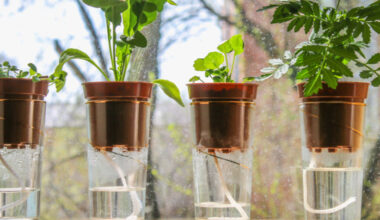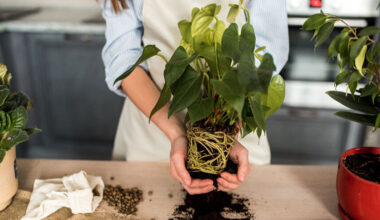Ivy grows everywhere. It grows in the shade as well as in the sun, in poor soil, indoors… Robust, ivy is resistant to pollution, wind and cold. Depending on the variety you choose, you can plant it in a pot, in suspension, as ground cover or as a climber.
Ivy can be planted at any time, but the best period is spring or fall. At the time of planting, no fertilizer is needed, simply a drainage layer (clay balls or gravel) at the bottom of the hole or pot. Once the root ball is in the ground, with the collar flush with the soil, all you have to do is fill in the soil, press it down and water it.
Contents
Where to plant ivy ?
Very easy to grow, it thrives in the shade as well as in the sun (except for a few rare varieties), and thrives even in the least rich soils.
The variegated climbing ivy will light up a shady area, provided that it gets a few hours of sunlight a day. Otherwise, they lose their variegation and take on a plain green color.
Hardy, ivy grows without much care or regular watering and resists well to the polluted atmosphere of cities.
They also adapt perfectly to indoor growing and make very good houseplants. For a culture in pot or in suspension, choose less rustic varieties, with low development and very coloured. Smaller varieties such as Hedera helix ‘Perkeo’ or ‘Goldchild’ will add some color to your other houseplants.
When to plant ivy?
Ivy can be planted all year round. It will take longer to establish if planted in the spring or fall.
Avoid planting ivy during frosty periods.
How to plant ivy?
Soak the bucket in a large volume of water, form a planting hole twice as large as the root ball to be buried.
Close the hole, pack the base and form a watering basin. Water generously.
Growing ivy in a pot
Ivy can be grown very easily in pots, in hanging pots for a hanging effect, or in tubs. Choose varieties with small growth and plan in advance the space that the ivy will take up over the years. Avoid planting ivy on a balcony without a trellis. It can grow quickly and overflow to your neighbors. Growing against a trellis allows for easier pruning and control of the plant. Then proceed as for the plantation in full ground.
How to maintain ivy ?
Watering
The first summer after planting, water the soil regularly to keep it fresh. After that, it is no longer necessary for plants in the ground. On the other hand, potted ivy needs to be watered regularly. Only keep the substrate fresh, without soaking the soil and by systematically emptying the saucer after each addition of water.
Pruning
Pruning is not mandatory but you may need to guide or restrict the development of the ivy. Climbing varieties that grow too thick can be cut back with a hedge trimmer or shears.
If you want your potted ivy to be a bit more compact, cut back the long stems in the spring. This will encourage new stems and leaves to appear.
Care
Fertilizer is not necessary. However, during the vegetation period, it accelerates the development of the plant. If you want to cover an unsightly wall quickly, then add liquid fertilizer twice a month. Potted ivy should be repotted every year with a container that is 1 inch larger than the previous one until it reaches maturity.
Cutting ivy
Ivy can be cut easily in any season! Here are the steps to follow.
- Cut young stems 4 inches to 5 inches long.
- Remove the leaves on the lower half.
- Plant them in a box filled with a mixture of soil (or potting soil) and sand.
- Place these pots at about 64-68°F.
- You will see new leaves in about 10 days, which means that roots have started to develop.
- Wait until you see new stems growing before transplanting the cuttings.
- At that point, transplant into the ground or into a pot!
Ivy pruning
When to prune ivy?
Prune ivy twice a year, in the spring, before the new leaves develop, and in August.
How to prune ivy?
Prune your ivy regularly to control its expansion according to your wishes:
- On a wall, trim it back with a hedge trimmer to limit its thickening. This will multiply the branches and make your plant more bushy and beautiful.
- In spring, cut back the stems to encourage the growth of new leaves.
- Also, regularly prune an ivy plant around a vigorous tree. Excessive growth of ivy could cause it to lose its vigor by choking it.
Does ivy kill trees?
Ivy wraps itself around trees with little spikes that allow it to cling. It is not a pest, since it does not draw sap from trees. As a climber, it uses the tree as a support to grow in the light.
In return, ivy protects the tree’s bark from cold temperatures and winds. Its leaves that fall to the ground also provide a rewarding cover. If a tree falls because of ivy, it is weak or diseased. In addition, ivy provides valuable berries for birds in winter and nectar-filled flowers in the fall for pollinators.
How do I get rid of ivy?
Sometimes you may want to destroy ivy that threatens a roof, for example. In this case, there is little point in pulling up its stems. You have to remove the roots! To do this, take a shovel or a spade and dig around the stem to remove the roots.
Dispose of it at the waste disposal center to prevent it from growing back. Then you can pull out all the stems to clear your wall. Then regularly monitor that the ivy does not grow back. If it does, pull up the young shoots as soon as they appear.
Pests and diseases of ivy
Ivy is very little affected by diseases or pests. Indoors, it may be attacked by mealybugs or red spiders. As their name indicates, mealybugs form small white and powdery blisters on the leaves and/or stems.
Red spider mites can be seen when water is sprayed on the foliage. Small threads can be seen between the stems and leaves. To scare away these two pests, spray with soapy water (10% liquid black soap to 90% water) at the beginning or end of the day. Repeat the operation as many times as necessary.









